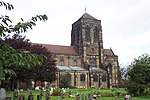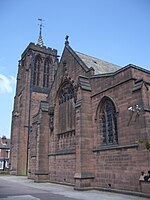Stretton and Claymills railway station
Disused railway stations in StaffordshireFormer Great Northern Railway stationsFormer North Staffordshire Railway stationsPages with no open date in Infobox stationRailway stations in Great Britain closed in 1949 ... and 5 more
Railway stations in Great Britain opened in 1848Staffordshire building and structure stubsUse British English from November 2017Vague or ambiguous time from April 2009West Midlands (region) railway station stubs

Stretton and Claymills railway station is a disused railway station in Stretton, near Burton upon Trent, Staffordshire.
Excerpt from the Wikipedia article Stretton and Claymills railway station (License: CC BY-SA 3.0, Authors, Images).Stretton and Claymills railway station
Station Walk, East Staffordshire Stretton
Geographical coordinates (GPS) Address Nearby Places Show on map
Geographical coordinates (GPS)
| Latitude | Longitude |
|---|---|
| N 52.8338 ° | E -1.6289 ° |
Address
Station Walk
Station Walk
DE13 0FS East Staffordshire, Stretton
England, United Kingdom
Open on Google Maps






